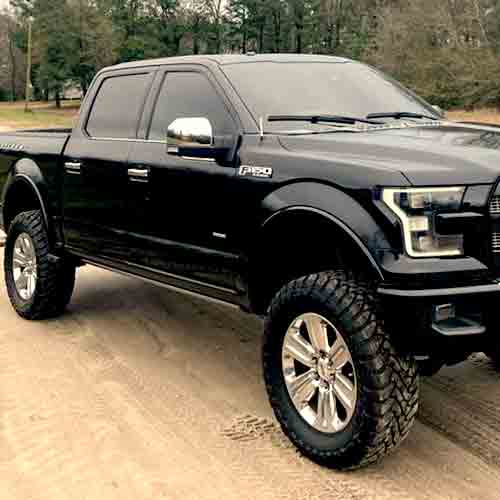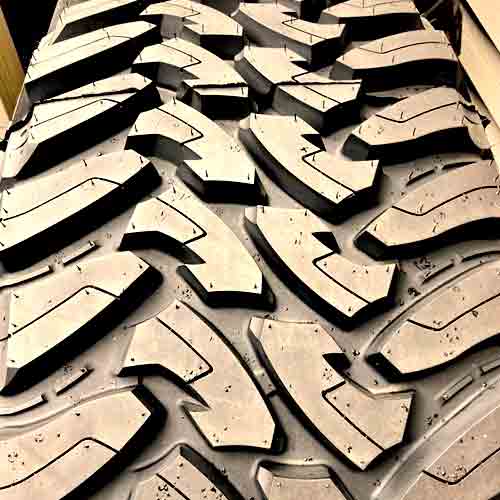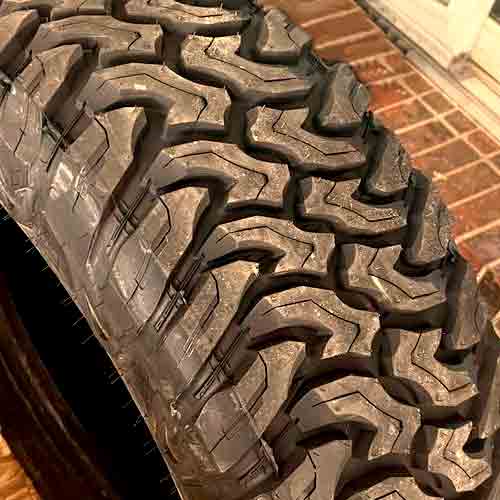Both Hankook Dynapro MT2 and the Toyo Open Country MT yield exceptional performance on all types of off-road tracks, thanks to their powerful/durable tread. Yet, they may still surprise you on pavements as well. Let’s check them out!

As a tire engineer, although both tires have similar muddy terrain performance, the Dyanpro MT2 is better on rocks and sand. Moreover, the tire also features superior wet and winter grip. On the other hand, the Toyo M/T is quieter, is more durable, and supplies greater dry traction on pavements.
Tire Sizing Guide
The Hankook Dynapro MT2 comes in 15 to 22 inches wheels, with following specs:
- Speed ratings: Q only.
- Load ratings: C to F.
- Weight range: 45 to 90 lbs.
- Tread depth: 15.5 to 18.5/32″.
- Winter ratings: None.
- Tredwear warranty: None.
Toyo Open Country M/T it comes with 83 total sizes in 15 to 26 inches with following specifications:
- Speed ratings: Q.
- Load range of C to F.
- Weight range: 50 to 110 lbs.
- Tread depth range: 17 to 21/32.
- No tread wear warranty or 3pmsf rating like the Dynapro.
Tread Pattern
Although both mud-terrain tires look very similar, the Toyo Open Country M/T features slightly more aggressive biters to its lugs.

It’s tread features 2 ribs in the middle making very tough passing longitudinal grooves.
All of these hook shaped lugs have sharp edges, and chamfered sides. They carry full depth siping, and have reinforced foundations underneath.
Moreover, compared to outer area (of the tread), they are more closed up together, allowing for good enough directional grip on roads.
Moving towards shoulders, the lugs are elongated, and have wider tread voids in between, carrying bold stone ejectors.
These blocks are staggered on the outer margins, and form N shaped sidewall lugs on each side of the tire.
The Hankook Dynapro MT2 on the other hand, also features a similar structure.

Like the Toyo M/T, it has 2 ribs in the middle as well, and they make similar L/U shaped lugs.
Though as these lugs are placed at an angle, they get to form a more efficient network of tread voids, connecting the outer shoulder gaps (having stone ejectors in them).
Consider 4 of these lugs in the middle, and see how they make “X” shaped groove together.
Moreover, these hook-shaped lugs also offer directional grip, as they make narrower longitudinal channels in between, just like its counterpart.
And with their wrapping design around the shoulders, the tire also gets lateral stability as well.
Moving on to the shoulder lugs, they are same on both tires, though on Hankook M/T2, they don’t make as big of the sidewall lugs.
Wet Surface Handling
The key to better wet traction is a focus on grip and resistance to hydroplaning. Let’s talk about them both.
Wet Grip
The Hankook Dynapro MT2 offer an all season rubber with greater density of silica in it, so it’s rubber stays soft and stretchable.
This allows the sipes/slits flexibility to create suction for the water particles, that come underneath the lugs (while the rest move out through the grooves).
On the other side, the Toyo M/T features a slightly harder rubber, which can’t offer sipes to expand/contract in a better way, relatively.
Hydroplaning
Hydroplaning is when a tire floats on a standing water, and it’s very dangerous. That’s why grooves are made, so that the water can escape.
Now there is no deficiency of grooves on Toyo MT, of course, being a mud tire, so it yields good enough path for water to leave out.
But is it better compared to Dynapro MT2?
Well, it’s just average, and there’s nothing extraordinary. You see, Toyo’s rigid tread does not create as much negative pressure to gush the water out.
Dry Pavement Performance
When it comes to traction on dry roads, you can’t expect too much from mud tires, as they really lack in both directional and lateral grip, along with steering response. Let’s talk about them one by one.
Directional Grip
The central lugs tell us about the directional grip, as that area gets to make the most contact with the surface, the tires on. And looking at both tires its pretty obvious why Hankook Dynapro MT2 lacks here.
Even though the tire still has closed up lugs compared to outer shoulder area, they still aren’t able to give out as much contact with the surface (its on), compared to its counterpart.
The Toyo MT on the other side shows shorter braking distances relatively.
Sideways Grip and Stability
The lateral traction of a tire is judged by considering the shoulders and here again the Hankook Dynapro MT2 with it’s such huge tread voids there, dedicated to bold stone ejectors, eat away the rubber that could have been in contact with the surface.
The Toyo Open Country on the other hand, is although not so great here either but in comparison, it’s handling is much more smoother.
Though by weighing more, the tire lacks slightly in providing as much steering response.
Fuel Consumption
Among the two tires, the Hankook Dynapro MT2 delivers better fuel efficiency due to its marginally lighter structure and stable lug formation.
Its dual tread compound provides reinforced support to the blocks, making them less prone to bending or flexing under weight pressure.
Conversely, the Toyo Open Country expends more energy as its tread blocks bear greater pressure. Coupled with its relatively softer tread compound, this results in increased rolling resistance values, ultimately affecting fuel efficiency.
Tread Life
When it comes to overall tread life of a tire, there are two main dimensions. There’s weight which tells you about the force with which the tire rolls on the surface, and then there’s the tread composition, which is a main contributing factor to rolling resistance, (as softer compounds tend to sticks).
The Toyo M/T although offers a ton of uneven biters, its relatively more rigid tread compound saves it form wearing off too quickly.
And for it’s greater weight, which pushes its lugs more to rub against the ground, it handles that with it’s relatively greater tread depth, which still takes longer to wear down to 2/32″ of legal tread depth limit.
So overall, here the Dynapro MT2 is the one lacking with its softer/high-silica density compound and shallower tread depth.
Though both tries don’t have any tread-wear warranty.
Sidewall Toughness
Durability is a crucial consideration for off-road tires, where the most crucial thing to consider is the toughness of the sidewalls.
That’s why in my experience both tires deliver the standard mud-terrain protection with 3 ply polyester, with 2 steel belts on top.
But if you really have to pick one here, go with Toyo MT, as that tire offer one extra cap ply and thicker/stiffer rubber on top, though both have cut resistant capabilities.
All Terrain Traction
Off-road I’ve had experience with these tires in the following terrains. Let’s discuss them all.
Muddy Trails
Mud needs efficient self cleaning from tires, and its one of the most challenging terrains out there.
That’s the reason why mud-terrain tires are named that way, though they do as much better on rocks and sand, as you’d see in the section below.
Though comparing both tires, I have to say, I am really impressed with them both, as you can’t put one over the other.
Their central lugs are spacious enough, and their sidewall blocks supply amazing paddling, throwing mud backwards and generating forward momentum with them.
Navigating Rocks
On rocks, you need toughness, as its the most puncturing terrains, and that’s a win for Toyo M/T with its superior cut resistant rubber, relatively, with greater Kevlar reinforcements in its compound.
And on this terrain you also need grip in all directions, now that’s the area where although both tires are almost equally capable. I would still have to go with Dynapro MT2.
This is because the tire comes with a greater chewing power with its comparatively softer compound that can bite in with greater force.
And with lowered air pressure its sidewall lugs are more able to grab and pull, even though both tires offer thick enough lugs there.
Soft Sand
Driving on sand demands a tire that excels in both flotation and shoveling capabilities. In this regard, the Hankook Dynapro MT2 outperforms its competition.
Thanks to its flexible tread, which becomes even more pliable when air pressure is reduced, the Dynapro MT2 enhances its grip on sand by expanding its sidewall lugs, providing a larger contact area.
In contrast, the Toyo Open Country falls short due to its sharper edges and aggressive rubber composition. Although its sidewall lugs are also thick, the tire’s heavier weight results in a denser overall structure, even when air pressure is lowered.
A denser tire is more prone to digging into the sand, which is detrimental to traction on such a surface. While the Toyo Open Country’s paddling efficiency is comparable to that of the Hankook Dynapro MT2, its density issues make it less suitable for sand driving overall.
On-Road Noise
Tire noise occurs when air particles, primarily entering through shoulder voids, collide with the tread walls.
The Toyo MT, with its comparatively fewer voids, deliver a quieter ride. Additionally, the tire benefits from improved pitch sequencing, incorporating subtle geometric variations in the blocks to create different tones as air particles impact them.
These varied tones or you can say frequencies, attempt to cancel each other out, reducing overall noise levels.
In contrast, the Dynapro MT2 tends to be significantly louder, primarily due to the in-groove resonance produced by its tread. This phenomenon results from echoing within the tread, and certain rubber compounds are more prone to it, including of course, the one used in this tire.
Snow Performance
Although neither tire has the 3-Peak Mountain Snowflake rating, it doesn’t mean that, they are incapable of performing on snow.
Admittedly, the limited sipes on their treads compromise traction on some surfaces, which especially include packed up snow, and yes they provide virtually no grip on ice.
However, both tires demonstrate above average proficiency in deep snow, where their thick blocks effectively scooping back the snow, generating forward momentum.
That’s why I rated both tires equally this aspect.
However, it’s important to note that the Dynapro MT2 is (slightly) better suited for more extreme winter conditions. Its rubber and tread compound are more thermally adaptive, allowing the biting edges to remain flexible even with negative freezing temperatures.
Final Thoughts
We strongly suggest not overlooking any of the content above, as it’s been meticulously researched. Nonetheless, for busy readers, here’s a quick recapitulation of the main points addressed.
When it comes to these (following) particular performance measures, the Hankook Dynapro MT2 stands out as a top performer.
- Wet grip.
- Winter traction.
- Sand traction.
- Rocky terrain grip.
- Fuel economy
On the other hand, the Toyo Open Country MT
- Road noise.
- Tread life.
- Dry grip.
Both tires have similar traction on muddy terrains.